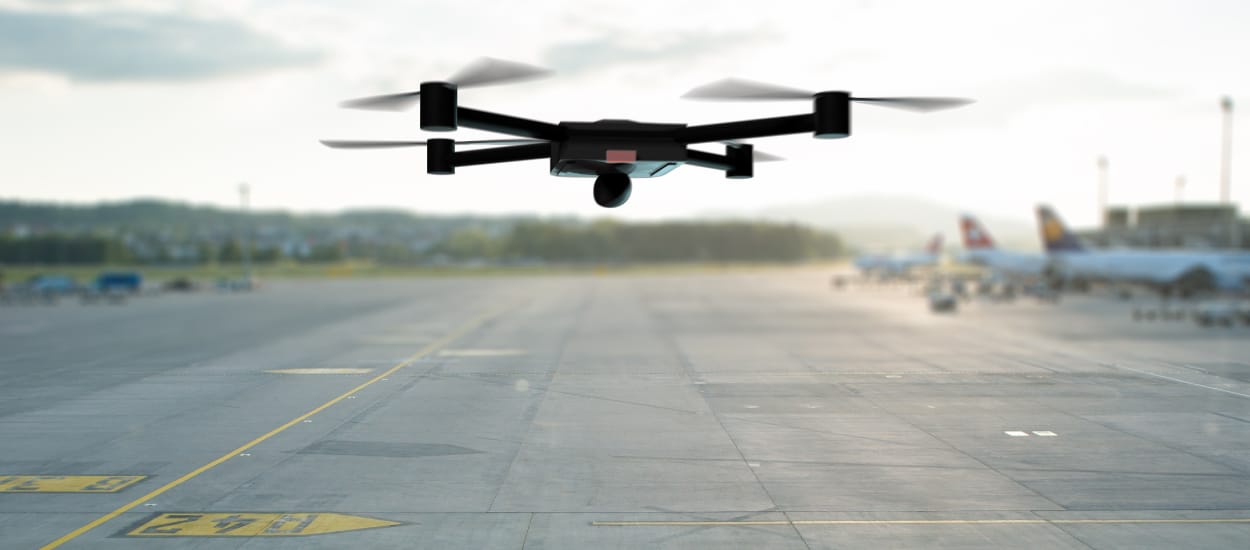Drone Detection: How to Monitor and Secure Your Organization’s Airspace

In recent years, drones – also referred to as unmanned aircraft systems (UAS) – have gained significant popularity. There is an increase in the use of drones in recreational activities, commercial and military applications.
Over 1.7 million registered drones include around 1.2 million recreational and 500,000 commercial, according to the Federal Aviation Administration (FAA).
- A recreational user flies a drone for fun.
- The commercial use of drones has many applications, such as delivery, search and rescue, weather forecast, aerial data collection, etc.
Whatever the reason for drone usage, they introduce security threats. For example, a recreational user flying a drone close to an airport poses a severe security breach for the airports, and could result in a physical collision or commercial disruption.
Different industries encounter different types of threats. The bottom line is that the rapid increase in drone usage has driven the expansion of anti-drone systems over the last decade.
This blog covers different verticals and security threats specific to each vertical, understanding existing regulations to help drone operators fly safely in the national airspace and how various drone detection technologies address today’s threats.
Industries and Airspace Security Threats
The best way to understand different threats is to look at each industry and identify security threats specific to that segment.
Let’s look at the following industries and airspace security threats:
- Critical Infrastructure – Threats posed are information espionage, physical collision, service disruption, terrorism attacks, cyber attack on data center using routers.
- Prisons – Threats posed are smuggling of contraband (drugs, weapons, cellphones), surveillance of security procedures and movements.
- Airports – Threats posed are physical collision and commercial disruption.
- Government Agencies – All the above.
We have learned about the specific threats. Now, let’s find out more about the operators. Drone operators can be careless pilots or individuals with bad intentions, such as terrorism and corporate espionage. Regardless of the operator’s intentions, there exists a severe security threat.
Drone detection technologies monitor and secure the airspace by detecting, positioning and mitigating the drones.
FAA Regulations
To address safety, security and privacy, FAA announced new rules on Dec 28, 2020. The new rules will require Remote Identification (Remote ID) of drones, and allow drone operators to fly over people and at night under certain conditions. These rules will become effective 60 days after publication in the Federal Register.
According to the Remote ID rule, the drone manufacturers must comply with Remote ID requirements within 18 months of the rule’s publication, and operators have an additional year to start using drones with Remote ID.
Secondly, the rule permits flying drones over people and at night under certain conditions, which means more drones may be in operation during the nighttime. FAA establishes four new categories of small unmanned aircraft for routine operations over people. These categories provide eligibility for operations over people.
Drone detection technologies capture the Remote ID and detect drones during the nighttime.
Detect, Position and Mitigate
Drone detection involves three levels: detection, positioning and mitigation.
Detection identifies the presence of a drone. The detection range can vary from 0.5 kilometers to several kilometers, based on the underlying technology.
The positioning determines the drone’s location, including a visual of the drone via a PTZ camera. The positioning range may vary between 600 meters and 5 kilometers under ideal conditions.
Mitigation involves disabling and confiscating a hostile drone. Many countries do not permit counter-drone actions by commercial entities or civilian users. Law enforcement and the military widely use various mitigation strategies.
Drone Detection Systems & Software Solutions
Drone detection uses several technologies: radio frequency (RF), radar, acoustic and optical. Each technology has its pros and cons, and ultimately, the accuracy of detection increases by using a combination of the above technologies.
The well-tested combination is using RF sensors with radar and video input, as it provides the location and tracking information. In some cases, it is also possible to identify the operator’s location.
Once the technology gets deployed, it can detect drone presence, but users still need to visualize the drone presence on a dashboard using the software.
Visualization software can be a 1) standalone cloud-hosted software, 2) an integration with a video management system (VMS) or a security monitoring solution or 3) both.
A standalone cloud-hosted software allows the users to visualize drone presence without any integrations. The software features vary quite a bit, but the basic features include detection and positioning notification, dashboard and reports, video feeds, heatmaps, setting rules and policies, tracking the path, and support integrations via API.
Integration with a VMS or security monitoring solution provides the end user with simple dashboard and reporting capabilities but provides a powerful overall integrated security solution.
Based on the organizational needs and types of threats, sensor deployment and software interface strategies are determined to maximize the ROI and achieve optimum detection and position accuracy.
Increase in Drone Detection System Adoption
Drone usage will only increase in the future. As a result, organizations will likely adopt drone detection solutions at a much faster rate.
Industries facing different types of threats in their airspace should deploy a drone detection strategy that addresses their specific threats and also accurately detects the drones.
Disclaimer: By using the Blog section of this website (“Blog”), you agree to the terms of this Disclaimer, including but not limited to the terms of use and our privacy policy. The information provided on this Blog is for information purposes only. Such information is not intended to provide advice on your specific security needs nor to provide legal advice. If you would like to speak to a Security representative about your specific security needs, please contact us.























